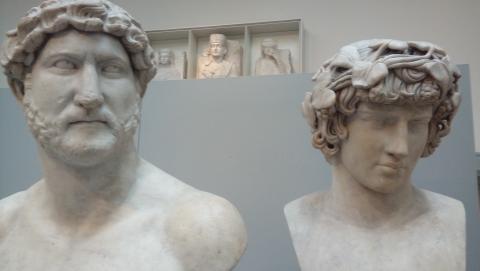Hadrian's Lasting Legacy

Hadrian is one of the five so-called ‘good’ emperors of ancient Rome. They were all pretty rotten in my mind, but they presided over an empire at its glittering best. To his credit, he implemented some modest legal protections for slaves, criminalised castration and rebuilt much of civic Rome. Unlike previous rulers, he visited most parts of the empire, including our misty isle, and commanded the construction of the great wall between Roman and barbarian lands. Hadrian’s influence continues to affect the modern world, in more ways than one.
Most free Roman men would now be described as bisexual, but Hadrian took this further, openly living with a young man called Antinous, while probably not consummating his official marriage. When the handsome Antinous drowned in the Nile during a pleasure cruise, the devastated emperor deified him, constructing temples and shrines the world over. Although the exaltation of same-sex relationships declined from the early Christian era, our culture’s growing admiration for such unions would have pleased old Hadrian. The two men's lifestyle, famed for its hedonism and passion, is imitated and esteemed throughout the modern Western world.
It was on Hadrian’s watch that the second Jewish revolt occurred. Previously, under Vespasian, the Temple had been destroyed when the first revolt was concluded in AD70. To punish the twice-defeated Jews, Hadrian renamed Jerusalem Aelia Capitolina, he exiled them from their land and he built an insulting temple to Jupiter on the old rubble of Herod’s. The Jewish diaspora which continues today was enlarged and formalised by Hadrian. Banished from Judaea, the Jews were forced to live in any lands but their own, a situation continuing until 1948. Today, when far-right and hard-left activists bemoan the influence of the Jews and decry their traditional homeland, I hear the archaic, vengeful whisper of Publius Aelius Hadrianus.
Thirdly, Hadrian had a poor relationship with the Senate, the political forum of Rome. Although the institution was far from democratic, it had traditionally advised emperors against excess and modified their desires. Hadrian was somewhat antagonistic to senators, ruling without them, establishing a blatantly absolute monarchy, and belying the sham of senatorial republic. History is awash with dictators, but countries in the 21st century seem to be subtly moving away from democratic power-sharing to the politics of the strong man. Turkey, for example, in 2017 moved from a parliamentary system of government to an ‘executive presidency’. The American Freedom House organisation claims 68 countries suffered a decline in political rights and civil liberties since February 2017. Examples of such nations are Hungary, Serbia and Russia. The prominence of presidential tough guys like Modi, Putin and Trump seem to be operating in Hadrian’s ancient shadow.
In the past, Emperor Hadrian provided an interesting chapter of Roman history. As our century wears on, his influence and preferences seem to be increasingly celebrated and emulated. Little wonder than Daniel’s interpretation of Nebuchadnezzar’s dream suggests fallen Rome is not quite over:
And the fourth kingdom shall be strong as iron: forasmuch as iron breaketh in pieces and subdueth all things: and as iron that breaketh all these, shall it break in pieces and bruise.
And whereas thou sawest the feet and toes, part of potters' clay, and part of iron, the kingdom shall be divided; but there shall be in it of the strength of the iron, forasmuch as thou sawest the iron mixed with miry clay.
And as the toes of the feet were part of iron, and part of clay, so the kingdom shall be partly strong, and partly broken. Daniel 2:40-42
If Rome is the strong and fierce kingdom of iron, the feet of iron and clay must be a later empire made up, in part, of Hadrian’s metal. Though politically and militarily weaker than the original, this Roman renaissance will surely include the antisemitic, political and sexual ideals of its illustrious progenitor.
Photo: busts of Hadrian and Antinous, which I took at the British Museum, 2018.
- Log in to post comments


 Sunday Worship 10.45am & 6.00pm
Sunday Worship 10.45am & 6.00pm